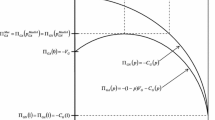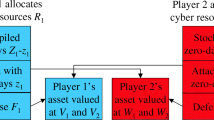Abstract
The paper considers optimal resource distribution between offense and defense in a duel. In each round of the duel two actors exchange attacks distributing the offense resources equally across K rounds. The offense resources are expendable (e.g. missiles), whereas the defense resources are not expendable (e.g. bunkers). The outcomes of each round are determined by a contest success functions which depend on the offensive and defensive resources. The game ends when at least one target is destroyed or after K rounds. We show that when each actor maximizes its own survivability, then both actors allocate all their resources defensively. Conversely, when each actor minimizes the survivability of the other actor, then both actors allocate all their resources offensively. We then consider two cases of battle for a single target in which one of the actors minimizes the survivability of its counterpart whereas the counterpart maximizes its own survivability. It is shown that in these two cases the minmax survivabilities of the two actors are the same, and the sum of their resource fractions allocated to offense is equal to 1. However, their resource distributions are different. In the symmetric situation when the actors are equally resourceful and the two contest intensities are equal, then the actor that fights for the destruction of its counterpart allocates more resources to offense. We demonstrate a methodology of game analysis by illustrating how the resources, contest intensities and number of rounds in the duels impact the survivabilities and resource distributions.
Similar content being viewed by others
Abbreviations
- r, R:
-
Actors’ resources
- ρ :
-
Ratio r/R between actor 1’s and actor 2’s resources
- x, X:
-
Offense-defense resource distribution parameters
- K :
-
Number of consecutive attacks
- s, S:
-
Target survivability (probability of survival in all K attacks)
- v, V:
-
Success probability of each attack
- p i , P i :
-
Probability that the target is destroyed in the i-th attack
- μ, m:
-
Contest intensities in attacks against the actors
- θ(q|K):
-
Conditional survivability of target 2 in q rounds of a K-round duel
- Θ(q|K):
-
Conditional survivability of target 1 in q rounds of a K-round duel
References
Anderson R (2001) Why information security is hard: an economic perspective. Presented at the 18th symposium on operating systems principles, October 21–24, Lake Louise, Alberta, Canada; also the 17th Annual Computer Security Applications Conference, December 10–14, New Orleans, Louisiana; http://www.cl.cam.ac.uk/~rja14/Papers/econ.pdf
Azaiez N, Bier VM (2007) Optimal resource allocation for security in reliability systems. Eur J Oper Res 181: 773–786
Bier VM, Abhichandani V (2002) Optimal allocation of resources for defense of simple series and parallel systems from determined adversaries. Proceedings of the engineering foundation conference on risk-based decision making in water resources X, Santa Barbara, CA: American Society of Civil Engineers
Bier VM, Nagaraj A, Abhichandani V (2005) Protection of simple series and parallel systems with components of different values. Reliab Eng Syst Safety 87: 315–323
Bier VM, Oliveros S, Samuelson L (2007) Choosing what to protect: strategic defense allocation against an unknown attacker. J Public Econ Theory 9(4): 563–587
Clausewitz CV (1832, 1984) On war. Princeton University Press, Princeton
Dighe N, Zhuang J, Bier VM (2009) Secrecy in defensive allocations as a strategy for achieving more cost-effective attacker deterrence, International Journal of Performability Engineering, special issue on system survivability and defense against external impacts 5(1):31–43
Hausken K (2004) Mutual raiding and the emergence of exchange. Econ Inquiry 42: 572–586
Levitin G (2007) Optimal defense strategy against intentional attacks. IEEE Trans Reliab 56(1): 148–156
Michaud D, Apostolakis G (2006) Methodology for ranking the elements of water-supply networks. J Infrastruct Syst 12(4): 230–242
Patterson S, Apostolakis G (2007) Identification of critical locations across multiple infrastructures for terrorist actions. Reliab Eng Syst Safety 92(9): 1183–1203
Skaperdas S (1996) Contest success functions. Econ Theory 7: 283–290
Tullock G (1980) Efficient Rent-Seeking. In: Buchanan JM, Tollison RD, Tullock G (eds) Toward a theory of the rent-seeking society. Texas A. & M. University Press, College Station, pp 97–112
Zhuang J, Bier VM (2007) Balancing terrorism and natural disasters—defensive strategy with endogenous attacker effort. Oper Res 55(5): 976–991
Author information
Authors and Affiliations
Corresponding author
Rights and permissions
About this article
Cite this article
Hausken, K., Levitin, G. Shield versus sword resource distribution in K-round duels. Cent Eur J Oper Res 19, 589–603 (2011). https://doi.org/10.1007/s10100-010-0148-5
Published:
Issue Date:
DOI: https://doi.org/10.1007/s10100-010-0148-5




